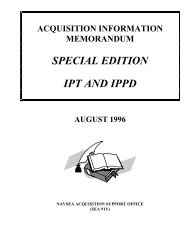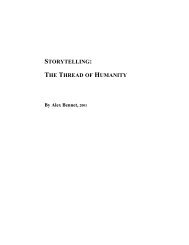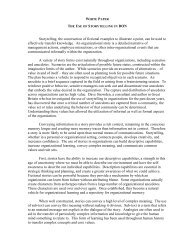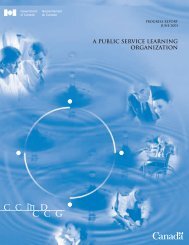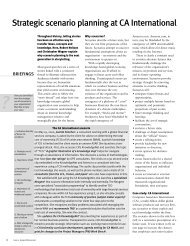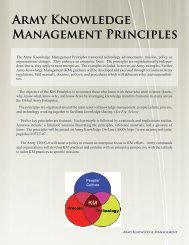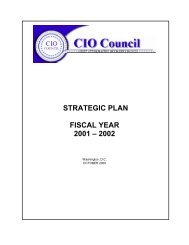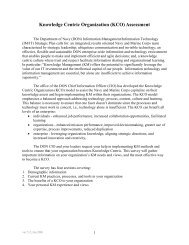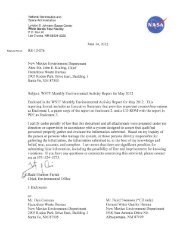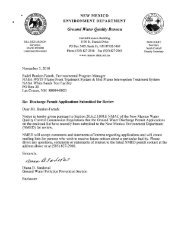NAVAL AVIATION SYSTEMS - NASA Wiki
NAVAL AVIATION SYSTEMS - NASA Wiki
NAVAL AVIATION SYSTEMS - NASA Wiki
You also want an ePaper? Increase the reach of your titles
YUMPU automatically turns print PDFs into web optimized ePapers that Google loves.
CHAPTER XII: RECENT ACQUISITION REFORM INITIATIVES<br />
PART C: ELECTRONIC PROPOSAL EVALUATION PROCESS<br />
Purpose: The "paperless" Electronic Proposal Evaluation System was developed for Navy Acquisition Teams by<br />
the Source Selection Office (AIR-4.10C) to aid in the evaluation of proposals while eliminating the volumes of<br />
paper which were by-products of the traditional evaluation process.<br />
Background: In response to the successful use of a "paperless" procurement for the Joint Strike Fighter<br />
Technology (JSF), NAVAIR has implemented a similar process for all future major and less-than-major formal<br />
source selections. Although similar to the JAST system, the AIR-4.10C system follows the formal source selection<br />
process that NAVAIR practices and was developed by computerizing the paper evaluation process. This is a<br />
significant expansion on the version used for the JAST Program Broad Area Announcement (BAA) evaluations.<br />
Discussion: The system is comprised of hardware and specially tailored software that are combined to receive and<br />
review offeror's proposals in a totally paperless process, while maintaining all the discipline and fidelity of the<br />
current NAVAIR system. This system accommodates up to SECRET material for review during the evaluation<br />
process. A closed LAN computer system that facilitates a "paperless" source selection has been established at a<br />
NAVAIR evaluation site. The hardware for the work stations consists of thirty personal computers connected to a<br />
primary and a backup server in an Advanced Windows NT network environment with shareable file structures<br />
containing access controls established via passwords. All evaluation efforts, including evaluation worksheets,<br />
summary worksheets, and the building of source selection briefing materials, will be conducted "on-line" using the<br />
network. The system can accommodate either floppy disk or CD/ROM formats and will have redundant backup<br />
systems for archival and recovery, if required.<br />
Most formal source selections have, as a minimum, a four team structure: Technical, Cost, Integrated<br />
Logistics Support and Management; with support from Contracts, Legal Counsel and AIR-4.10C. The server and<br />
back-up server have sufficient storage capacity to handle multiple proposals and be able to handle multiple<br />
evaluation personnel working simultaneously. the system is able to use software presently in use on the NAVAIR<br />
network, i.e. Word, Powerpoint and Excel from Microsoft, in addition to the "evaluation" software being produced<br />
by NAWC. It allows all proposals to be read on a computer screen, with the capability to simultaneously call up<br />
forms to prepare evaluations, questions to Offerors, and briefing slides. A network administrator is required.<br />
The evaluation process is patterned after the existing NAVAIR evaluation process and team structure with<br />
SSEB, SSAC, SSA, designated Team Leaders, Sub-team Leaders, and Evaluators. The worksheets, which are<br />
completed by the Evaluators, serve as the inputs to the summary worksheets that are then forwarded up the line for<br />
review and approval. The system produces Evaluation Notices (ENs) which, when approved, are sent to the<br />
contractors if discussions are initiated. All files are archived for future use as required.<br />
The computer equipment and software have been installed so that each user can perform all evaluations at<br />
their workstations, virtually free of paper. Each workstation supports the concurrent use of the worksheet software<br />
and the supporting Offeror's documents, so that the user can switch readily from one to another.<br />
The individual workstations are connected to each other via a local area computer network. This enables<br />
information to be shared amongst users as appropriate. It also allows for "chatting" from station to station for the<br />
exchange of messages and other forms of text.<br />
The security aspects of having classified material on the network represent a significant requirement of the<br />
system. The system is designed to handle technical proposals received that are classified as high as SECRET.<br />
Problems: To use a "paperless" system for electronic proposal evaluation requires the accomplishment of an<br />
increased volume of "up front" work. The evaluation criteria and Proposal Instructions of the RFP must be<br />
carefully integrated, as they will become the basis for inputs for setting up the electronic evaluation. Extraordinary<br />
79



